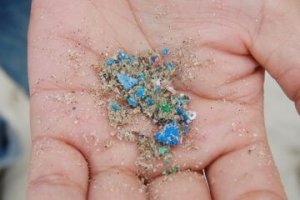Friends of China Camp – Spring 2021
TALKING TRASH: TOO MUCH PLASTIC IN OUR PARK
Record visitation brings more litter to China Camp
By Matt Ferner, Marine Biologist & Research Director, San Francisco Bay National Estuarine Research Reserve
 The pandemic brought more people outdoors, including to parks and open space areas along the shores of San Francisco Bay. Unfortunately, this healthy trend toward outdoor recreation also came with more takeout and packaged foods brought for snacks and picnics, leading to an increase in litter.
The pandemic brought more people outdoors, including to parks and open space areas along the shores of San Francisco Bay. Unfortunately, this healthy trend toward outdoor recreation also came with more takeout and packaged foods brought for snacks and picnics, leading to an increase in litter.
 At China Camp State Park, perhaps you’ve noticed more trash around the village, in pull-offs, or in picnic areas. Unfortunately, litter also collects in places that we rarely see up close when we visit the park. The salt marsh at China Camp is one of those environmentally sensitive places.
At China Camp State Park, perhaps you’ve noticed more trash around the village, in pull-offs, or in picnic areas. Unfortunately, litter also collects in places that we rarely see up close when we visit the park. The salt marsh at China Camp is one of those environmentally sensitive places.
Trash discarded or lost by visitors affects more than just the beauty of our park; it also harms fragile salt marshes and the wildlife that call these marshes home. Birds and fish unknowingly eat carelessly discarded plastic bags, straws, and wrappers, or become entwined in them, which reduces animal health and chances of survival.
The damage doesn’t stop there. Instead of decomposing, plastic litter breaks apart into smaller and smaller pieces until only tiny particles remain. These tiny particles, known as microplastics, can accumulate in animals and spread through the ocean to affect fish and ultimately human health.
How you can make a difference
What can you do about it? The simple answer is to reduce your use of plastics and don’t litter. Say no to disposable utensils when they’re offered at restaurants or eateries. Instead, bring your own reusable utensils, bottles, and drinking cups to the park. Pack cloth instead of paper napkins too. Make sure everything you bring into the park is either safely disposed of in the park’s garbage receptacles, or pack it out yourself. Remind others to do the same.
 You can also do more to help reduce litter in the park by leaving it better than you found it. First, speak up when you see others littering. Second, bring a bag and a pair of gloves to pick up and carry out litter when you can.
You can also do more to help reduce litter in the park by leaving it better than you found it. First, speak up when you see others littering. Second, bring a bag and a pair of gloves to pick up and carry out litter when you can.
It helps to remember that not all litter at China Camp was discarded within the park’s boundaries. Streams and rivers throughout nearly half of California flow into San Francisco Bay, carrying trash and litter downstream to places like the beach at China Camp Village, and to our salt marshes. So, wherever you are and wherever you go, you can play a big part in reducing litter and limiting plastics in the environment.
Want to do even more? Help monitor and remove trash from the shores of San Francisco Bay by joining important community science initiatives like Litterati and Nurdle Patrol. Check out the San Francisco Bay Microplastics Project website for more information about what’s being done to reduce microplastics.
Editor’s note: Friends of China Camp also organizes volunteer work days, which often include trash pickup. To sign up, please visit our volunteer sign-up page.
Photo credits: (top) Sarah Ferner/National Estuarine Research Reserve; (bottom) courtesy of Geographical.co.uk
Find out more about NERR’s work at China Camp and other locations.

